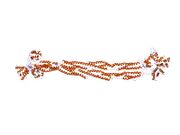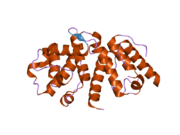Biology:Alpha-actinin-1
 Generic protein structure example |
Alpha-actinin-1 is a protein that in humans is encoded by the ACTN1 gene.[1]
Function
Alpha actinins belong to the spectrin gene superfamily which represents a diverse group of cytoskeletal proteins, including the alpha and beta spectrins and dystrophins. Alpha-actinin-1 is an F-actin cross-linking protein – a bundling protein that is thought to anchor actin to a number of intracellular structures.[2] Alpha-actinin-1 is a non-muscle cytoskeletal isoform found along microfilament bundles and adherens-type junctions, where it is involved in binding actin to the membrane. In contrast, skeletal, cardiac, and smooth muscle isoforms are localized to the Z-disc and analogous dense bodies, where they help anchor the myofibrillar actin filaments.[3]
Interactions
Alpha-actinin-1 has been shown to interact with:
- CDK5R1,[4]
- CDK5R2,[4]
- Collagen, type XVII, alpha 1,[5]
- GIPC1,[6]
- PDLIM1,[7][8]
- Protein kinase N1,[9]
- SSX2IP,[10] and
- Zyxin.[11][12]
- PTPRT (PTPrho)[13]
See also
References
- ↑ "Cloning and chromosomal localization of the human cytoskeletal alpha-actinin gene reveals linkage to the beta-spectrin gene". Am J Hum Genet 47 (1): 62–72. Jul 1990. PMID 2349951.
- ↑ "ACTN2 - Alpha-actinin-2 - Homo sapiens (Human) - ACTN2 gene & protein" (in en). https://www.uniprot.org/uniprot/P35609.
- ↑ "Entrez Gene: ACTN1 actinin, alpha 1". https://www.ncbi.nlm.nih.gov/sites/entrez?Db=gene&Cmd=ShowDetailView&TermToSearch=87.
- ↑ 4.0 4.1 "The cyclin-dependent kinase 5 activators p35 and p39 interact with the alpha-subunit of Ca2+/calmodulin-dependent protein kinase II and alpha-actinin-1 in a calcium-dependent manner". J. Neurosci. 22 (18): 7879–91. September 2002. doi:10.1523/JNEUROSCI.22-18-07879.2002. PMID 12223541.
- ↑ "Interactions of a hemidesmosome component and actinin family members". J. Cell Sci. 114 (Pt 23): 4197–206. December 2001. doi:10.1242/jcs.114.23.4197. PMID 11739652. https://cdr.lib.unc.edu/downloads/d217qz52s.
- ↑ "Protein interactions with the glucose transporter binding protein GLUT1CBP that provide a link between GLUT1 and the cytoskeleton". Mol. Biol. Cell 10 (4): 819–32. April 1999. doi:10.1091/mbc.10.4.819. PMID 10198040.
- ↑ "CLP-36 PDZ-LIM protein associates with nonmuscle alpha-actinin-1 and alpha-actinin-4". J. Biol. Chem. 275 (15): 11100–5. April 2000. doi:10.1074/jbc.275.15.11100. PMID 10753915.
- ↑ "Human CLP36, a PDZ-domain and LIM-domain protein, binds to alpha-actinin-1 and associates with actin filaments and stress fibers in activated platelets and endothelial cells". Blood 96 (13): 4236–45. December 2000. doi:10.1182/blood.V96.13.4236. PMID 11110697.
- ↑ "Pathological shear stress stimulates the tyrosine phosphorylation of alpha-actinin associated with the glycoprotein Ib-IX complex". Biochemistry 41 (4): 1100–8. January 2002. doi:10.1021/bi0156005. PMID 11802708.
- ↑ "ADIP, a novel Afadin- and alpha-actinin-binding protein localized at cell-cell adherens junctions". J. Biol. Chem. 278 (6): 4103–11. February 2003. doi:10.1074/jbc.M209832200. PMID 12446711.
- ↑ "An alpha-actinin binding site of zyxin is essential for subcellular zyxin localization and alpha-actinin recruitment". J. Biol. Chem. 274 (19): 13410–8. May 1999. doi:10.1074/jbc.274.19.13410. PMID 10224105.
- ↑ "Analysis of the alpha-actinin/zyxin interaction". J. Biol. Chem. 276 (36): 33328–35. September 2001. doi:10.1074/jbc.M100789200. PMID 11423549.
- ↑ "Intracellular substrates of brain-enriched receptor protein tyrosine phosphatase rho (RPTPrho/PTPRT).". Brain Res 1116 (1): 50–7. 2006. doi:10.1016/j.brainres.2006.07.122. PMID 16973135. https://www.ncbi.nlm.nih.gov/entrez/eutils/elink.fcgi?dbfrom=pubmed&tool=sumsearch.org/cite&retmode=ref&cmd=prlinks&id=16973135.
Further reading
- "The cleavage of host cell proteins by HIV-1 protease.". Folia Biol. (Praha) 42 (5): 227–30. 1997. doi:10.1007/BF02818986. PMID 8997639.
- "Integrins and development: how might these receptors regulate differentiation of the lens.". Ann. N. Y. Acad. Sci. 842: 36–41. 1998. doi:10.1111/j.1749-6632.1998.tb09629.x. PMID 9599291.
- "Alpha-actinin and vinculin in human neutrophils: reorganization during adhesion and relation to the actin network.". J. Cell Sci. 101 (2): 403–14. 1992. doi:10.1242/jcs.101.2.403. PMID 1629252.
- "Transfection of chicken skeletal muscle alpha-actinin cDNA into nonmuscle and myogenic cells: dimerization is not essential for alpha-actinin to bind to microfilaments.". Exp. Cell Res. 197 (2): 158–67. 1992. doi:10.1016/0014-4827(91)90418-T. PMID 1720388.
- "Non-viral cellular substrates for human immunodeficiency virus type 1 protease.". FEBS Lett. 278 (2): 199–203. 1991. doi:10.1016/0014-5793(91)80116-K. PMID 1991513.
- "Expression of human alpha-actinin in human hepatocellular carcinoma.". Cancer Res. 50 (19): 6291–4. 1990. PMID 2169343.
- "The cDNA sequence of a human placental alpha-actinin.". Nucleic Acids Res. 17 (16): 6725. 1989. doi:10.1093/nar/17.16.6725. PMID 2780298.
- "Identification of the cytoskeletal protein alpha-actinin as a platelet thrombospondin-binding protein.". FEBS Lett. 364 (2): 109–14. 1995. doi:10.1016/0014-5793(95)00362-D. PMID 7750553.
- "Interaction of alpha-actinin with the cadherin/catenin cell-cell adhesion complex via alpha-catenin.". J. Cell Biol. 130 (1): 67–77. 1995. doi:10.1083/jcb.130.1.67. PMID 7790378.
- "Modulation of alpha-actinin levels affects cell motility and confers tumorigenicity on 3T3 cells.". J. Cell Sci. 107 (7): 1773–82. 1995. doi:10.1242/jcs.107.7.1773. PMID 7983147.
- "Oligo-capping: a simple method to replace the cap structure of eukaryotic mRNAs with oligoribonucleotides.". Gene 138 (1–2): 171–4. 1994. doi:10.1016/0378-1119(94)90802-8. PMID 8125298.
- "Identification of the 70kD heat shock cognate protein (Hsc70) and alpha-actinin-1 as novel phosphotyrosine-containing proteins in T lymphocytes.". Biochem. Biophys. Res. Commun. 224 (3): 666–74. 1996. doi:10.1006/bbrc.1996.1082. PMID 8713105.
- "Interaction of PKN with alpha-actinin.". J. Biol. Chem. 272 (8): 4740–6. 1997. doi:10.1074/jbc.272.8.4740. PMID 9030526.
- "Construction and characterization of a full length-enriched and a 5'-end-enriched cDNA library.". Gene 200 (1–2): 149–56. 1997. doi:10.1016/S0378-1119(97)00411-3. PMID 9373149.
- "The epidermal growth factor receptor modulates the interaction of E-cadherin with the actin cytoskeleton.". J. Biol. Chem. 273 (15): 9078–84. 1998. doi:10.1074/jbc.273.15.9078. PMID 9535896.
- "Protein interactions with the glucose transporter binding protein GLUT1CBP that provide a link between GLUT1 and the cytoskeleton.". Mol. Biol. Cell 10 (4): 819–32. 1999. doi:10.1091/mbc.10.4.819. PMID 10198040.
- "An alpha-actinin binding site of zyxin is essential for subcellular zyxin localization and alpha-actinin recruitment.". J. Biol. Chem. 274 (19): 13410–8. 1999. doi:10.1074/jbc.274.19.13410. PMID 10224105.
External links
- Actinin, alpha 1 Info with links in the Cell Migration Gateway
- Human ACTN1 genome location and ACTN1 gene details page in the UCSC Genome Browser.




